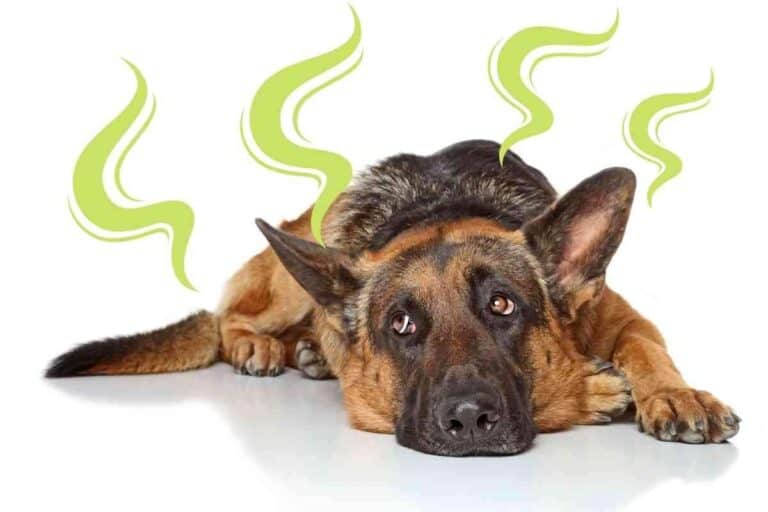The 6 Rarest German Shepherd Colors (Ranked!)
When people think of German Shepherds, they tend to think of their common sable-colored coats or maybe their solid black or brown coats. However, there are many more variations of the German Shepherd look, all with their levels of rarity.

What’s the rarest color of German Shepherd?
Several coat colors of the German Shepherd have fought to be the rarest of them all. The rarest German Shepherd color is considered to be the panda pattern. These black and white German Shepherds are hardly ever seen.
Panda-Patterned German Shepherds
German Shepherds that are panda colored have symmetrical black and white patterns on their coat that is similar to the patterns that bi-colored German Shepherds have.
The reason for the panda looks that these German Shepherds have is because of a mutation of the KIT gene. This gene has to deal with coat colors and patterns that the German Shepherd has. This mutation causes the white part of their coat coloring.
The first panda-patterned German Shepherd was born back in the year 2000 by two purebred German Shepherds. With them being so rare and having such a striking look, they are not recognized by the AKC.
What Other German Shepherd Colors Are Rare?
The panda German Shepherds are not the only kind of German Shepherd that is rare. In fact, Several more colorings are so rare that they are also not recognized by the AKC. This organization has very strict rules for dogs and anything that is outside the norm is typically not recognized as valid for dog shows.
Liver German Shepherds
The liver German Shepherd fought to be the rarest German Shepherd color, but they are not the rarest.
The color of the liver German Shepherd can be described as a lighter brown. The tone also has hints of red mixed in, creating a reddish-brown that is unlike the normal reds and browns that German Shepherds can commonly be. There are even variations amongst this coat coloring. A German Shepherd can be solid liver, liver and tan, and liver and white.
Unlike the panda color, which is caused by a genetic mutation, the liver color of German Shepherds is caused by recessive genes. If both of the parents of a German Shepherd possess a B locus gene (the recessive gene for the liver coloring), then the offspring German Shepherd might be liver.
When a German Shepherd is born liver, it will stay that color throughout its life. This coat coloring is not susceptible to change with age as other colors are.

Blue
The blue German Shepherd completes the top 3 rarest German Shepherd colors. They are also not recognized by the AKC as both blue and liver German Shepherds are considered to be serious faults.
Now, blue German Shepherds aren’t actually blue. Their color can be described as dark grey mixed with hues of blue. They have a slight bluish look, but German Shepherds can’t be very blue.
Once again, this interesting coat color is caused by recessive genes like liver is. The parents of a blue German Shepherd must have a black coat coloring and possess the recessive gene for the blue coat. The recessive gene completely blocks the black gene in their coat for liver German Shepherds. For blue German Shepherds, the recessive gene only partially blocks the black gene, which is how they are darker in color and is where the blue hue comes from.
What is interesting is how the liver and blue recessive gene interact with each other but what causes the two very different colors is how much the recessive gene interacts with the black genes that the parents have.
Isabella German Shepherds
Isabella German Shepherds might also be called fawn German Shepherds. It is still very unlikely that you will ever see an Isabella German Shepherd from how rare they are, but you have a better chance with Isabella German Shepherds than liver German Shepherds.
The names “Isabella” and “fawn” don’t give a lot of description of what color these German Shepherds are. However, fawn gives a closer hint as it is said that fawn German Shepherds have coats that mimic the colors of deer. Their coats are a light reddish tan or a darker cream color.
A German Shepherd becomes an Isabella German Shepherd through recessive genes. The A-Locus gene controls the Isabella look of German Shepherds. This gene can also be combined with other color genes, which can create mixes of colors. A German Shepherd can be Isabella and tan, among other variations. The parents of Isabella German Shepherds have red genes, and the A-Locus gene blocks the red in these German Shepherds, which is what causes their lighter color.
Grey German Shepherds
While they have a similar look to blue German Shepherds due to their grey color, they come from different gene changes that are inherited by their parents. There isn’t a gene that causes the specific grey color, instead, this color is caused by genes blocking the colors of other genes.
The black gene is diluted for grey German Shepherds, and the red gene is blocked. This prevents them from becoming either blue or liver. Specifically, this color is caused by the agouti gene interacting with the red gene pool.
Grey German Shepherds are rare because they have several colors impacted in their color pattern. It is also hard to get a specifically grey German Shepherd because they could easily become a liver or blue German Shepherd.
White German Shepherds
White German Shepherds are a kind of German Shepherd that you might see in your lifetime. They are rare, but not nearly as rare as the other colors of German Shepherds listed above. However, they still get a special mention because they aren’t allowed to be in dog shows according to the AKC because their white coats are considered a fault.
The white color of German Shepherds is caused by a white recessive gene which is why they are considered rare. Recessive genes are difficult to control because they are so many chances that other genes can pull through.
White German Shepherds are beautiful with their bright white coats, and they are much more possible to own as a pet as well.
Do Any of The Rare German Shepherd Have Health Problems?
Usually, the color of a German Shepherd doesn’t impact their health. They have all the same health problems as the average German Shepherd and have similar lifespans as well.
However, rarer colors can have health problems due to inbreeding. With there being so few certain colors of German Shepherds, breeders might use irresponsible breeding habits to get more of those German Shepherds.
Frequent inbreeding causes health problems in any dog as the health issues that the breed normally faces will be magnified.
Also, irresponsible breeding practices might include breeding German Shepherds even if they have many health issues. Responsible breeders won’t breed dogs that have health issues that can be passed down. However, when a breeder is trying to get more of a rare color, they will breed any and all German Shepherd of that color if they are irresponsible breeders.
When looking to buy a German Shepherd or any dog, look into the breeder’s reputation and make sure that they follow safe breeding practices. Buying from an irresponsible breeder increases the chance of getting a German Shepherd with many health problems and may not live for as long.
Will A Rare German Shepherd Have Different Eye Colors?
Eye color is sometimes linked to the color of the German Shepherd that you have. However, the changes usually aren’t that frequent.
Grey or liver German Shepherds can have amber eyes, while the typical eye colors for German Shepherds are brown, gold, or blue. Blue German Shepherds tend to have blue-colored eyes, which is an amusing concept.
Outside of those changes, even the rarer German Shepherds can have typical colored eyes.
Final Thoughts
There are many colors of German Shepherds that are super rare and aren’t even recognized by the AKC. But the rarest German Shepherd color out there is a panda-colored German Shepherd. Instead of being caused by recessive genes like how most rare color patterns are caused, the panda look is caused by a genetic mutation.
Blue and liver German Shepherds are the next rarest after panda German Shepherds. These fur colors are caused by recessive genes blocking other gene colors. Typically, red and black genes get diluted or canceled out to make way for these rarer German Shepherd colors.
Being a different color German Shepherd doesn’t impact a German Shepherd’s health on its own. However, rare colors of German Shepherds are more susceptible to being a part of irresponsible breeding practices that can harm the health of a German Shepherd.
All kinds of German Shepherds are beautiful with their unique color patterns. Even though it is not likely that people will see a panda, liver, or blue German Shepherd in person, they are still a possibility to happen when a German Shepherd is born.






